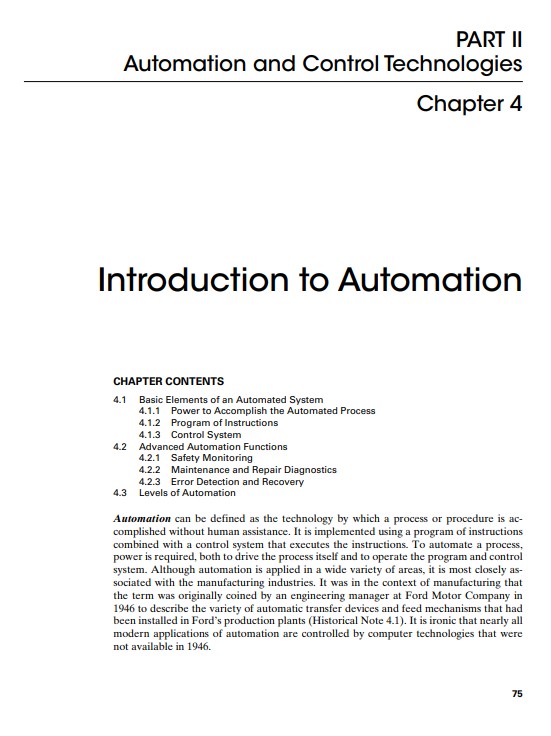Automation and Control Technologies
Summary:
The note discusses Automation and Control Technologies, focusing on the introduction to automation. It explains an automated system’s basic elements, including power, a program of instructions, and control systems. Advanced automation functions such as safety monitoring, maintenance and repair diagnostics, and error detection and recovery are also covered. The note further highlights the different levels of automation and its origins in the manufacturing industry, dating back to 1946 when an engineering manager at Ford Motor Company coined the term. Interestingly, most modern automation applications are now controlled by computer technologies that were unavailable then.
Excerpt:
Automation and Control Technologies
Chapter Contents
4.1 Basic Elements of an Automated System
4.1.1 Power to Accomplish the Automated Process
4.1.2 Program of Instructions
4.1.3 Control System
4.2 Advanced Automation Functions
4.2.1 Safety Monitoring
4.2.2 Maintenance and Repair Diagnostics
4.2.3 Error Detection and Recovery
4.3 Levels of Automation
Automation can be defined as the technology by which a process or procedure is accomplished without human assistance. It is implemented using a program of instructions combined with a control system that executes the instructions. Power is required to automate a process to drive the process itself and to operate the program and control system. Although automation is applied in a wide variety of areas, it is most closely associated with the manufacturing industries. In the context of manufacturing, the term was originally coined by an engineering manager at Ford Motor Company in 1946 to describe the variety of automatic transfer devices and feed mechanisms installed in Ford’s production plants (Historical Note 4.1). Ironically, nearly all modern automation applications are controlled by computer technologies that were not available in 1946.
Historical Note 4.1 – History of Automation
The history of automation can be traced to the development of basic mechanical devices,
such as the wheel (circa 3200 B.C.), lever, winch (circa 600 B.C.), cam (circa 1000), screw
(1405), and gear in ancient and medieval times. These basic devices were refined and used to
construct the mechanisms in waterwheels, windmills (circa 650), and steam engines (1765).


Reviews